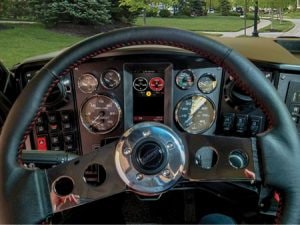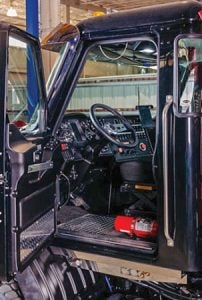Do not settle for a cookie-cutter truck. Choose your refuse truck carefully with special attention to the cab and you will experience greater profit, better customer service and lower driver turnover.
When it comes right down to it, the only reason you are going to buy a new garbage truck is to make some money with it. So, it should go without saying that the workspace of the truck—the cab—is central to achieving that goal.
Yet many refuse truck buyers do not know how to judge a cab when choosing a truck. That could be because so many cabs were designed years ago for general use across many different vocations. Those generic cabs might work out okay for box trucks, but they will never deliver the best performance in a refuse operation. That means you will never make the profit—or satisfy your customers—as well as if you choose a truck with a cab specifically designed for refuse work. Let’s dig into why that is.

Structure
The first reason you need a severe-duty truck cab built specifically for refuse is the sheer beating waste collection gives a truck, year after year after year. The stops and starts, the getting in and out, the inadvertent bangs. The pulling down on the doors as the driver climbs in. Each of these stresses means an ordinary truck cab will have problems sooner than one built especially for refuse work.
Ask if the cab you are looking at has steel doors. Does it also have a steel roof? Does the dashboard have a steel substructure or is it just plastic bolted on to the firewall? The answers may surprise you as many supposedly “refuse” truck builders cannot say “yes” to all three questions.
Ergonomics
Let’s turn to ergonomics. That is a fancy word that means your driver can work hard all day long without over-reaching for switches, without getting tired and while staying alert. Every truck maker says they have it, but they are mostly fudging. Why? Because those older truck cabs were designed in a long-past era. Drivers today, in general, are bigger than past generations—sometimes over 300 lbs. But they are also smaller than before as well, now that more drivers are women. The newest, modern, conventional cab brings a big improvement because it covers the full range of drivers from 5th percentile women to 95th percentile men. State-of-the art ergonomic-simulation software can help to optimize a whole range of factors, from gauge readability, controls reach, and comfort adjustments, to the placement and spacing of steps and grab handles.
Before you make your decision on a new truck, see if a small person can find a comfortable seating position with good visibility. Check if your extra tall or otherwise large employees can adjust the steering wheel to make room or avoid hitting their head on the roof when they hit a pothole or bounce through a landfill. You might be surprised that taller drivers lose a huge amount of upward visibility in some trucks. That explains why they might run a red light or hit an overhanging tree branch. Choose a cab that was designed to accommodate them from the beginning.
Visibility
Since we mentioned visibility, let’s look into that topic more carefully. Visibility is all about safety. Many trucks have narrow and nearly vertical windshields. Be sure yours is wrap-around, so objects to the sides are seen well before they are bumped. A steeply raked windshield gives superior upward visibility as well. What about rearward visibility? Large rear corner windows make a big difference not only when backing up—the most dangerous maneuver a driver makes—but also when turning, because those corner windows eliminate blind spots.
Consider the cost one accident with injuries can impose on your company or on you. Those tragedies can be avoided for the most part. Buying a truck with the best visibility can make all the difference. Ask your truck company rep to show you actual safety data on their trucks and how they compare to refuse industry averages. If they do not have that data handy, you can guess why.

Uptime
Your truck cannot make you money when it is broken down, waiting at the dealer to be repaired. Look carefully at your truck cab to see how reliability is built in. Will your truck cab have a smart electrical system with fuse boxes that communicate to your techs? That will avoid long hours of diagnostic time. Does it have body controls and wiring harnesses installed by the truck maker? Or are they spliced-in by someone else long after your truck was built? You need to ask this hard question and listen carefully to the answer. Those post-production modifications can be the source of corrosion, shorts, rubbed wires and downtime. They are still all too common. If your truck is really built for the refuse application you are going to use it for, it will have the body controls and all body wiring pre-installed by the truck OEM at the factory.
Diagnostic Technology
Also essential to maximizing the earning potential of your truck is new diagnostic technology, which alerts you to problems early on and helps your techs get your truck back into service faster. We are not talking about the common on-board diagnostics every truck is required to have.
Look for cabs that feature the latest diagnostic systems displayed on a large screen in the dashboard. The trucks actually monitor and diagnose themselves in real-time, not only alerting techs of issues, but also showing an easy-to-understand description of what fault has occurred as well as the actual electrical schematic for your truck and how to fix the problem. The best diagnostics enable trucks to be rapidly root-caused and placed back into service, making money again—and all this without a laptop, cables, special equipment or software subscriptions. A system like this is pure gold for you, helping you to serve your customers without schedule disruptions due to down trucks. Your drivers will be happier too, not having to drive that old spare.
Damage Resistance
Last, but not least, is your new garbage truck cab interior designed to be damage resistant and easily repaired? Or is it filled with plastic desperately trying for that “automotive” look? If you are planning to run your trash truck for a few years, make sure it is going to stand up to the abuse. Ask if the dashboard is specifically designed for severe-duty durability and to enable mounting of accessories directly to the structure. If yes, the panel surfaces will be real metal—steel or aluminum—with exposed fasteners. Not plastic.
Check if there is easy access from within the cab to the HVAC system, to the cab roof-mounted components, to the transmission, to the rear of the engine, to the fuse boxes, the control modules and even the wiring inside the A-pillars. If service is required, technicians can quickly gain access to the location of the issue and get the truck back into service. If no, repairs will take hours longer, costing you more money. These features are not common, but they will make a big difference in your bottom line.
Do not settle for a cookie-cutter truck. Choose your refuse truck carefully with special attention to the cab and you will experience greater profit, better customer service and lower driver turnover. | WA
For more information, visit www.autocartruck.com/my-new-truck. Autocar Trucks offers a no-obligation consultation on refuse truck specifications.
